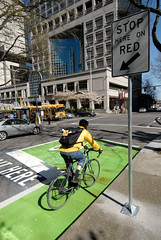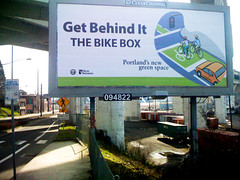A year-long evaluation by researchers at Portland State University’s Institute for Bicycle and Pedestrian Innovation has found that Portland’s bike boxes improve the safety of roads users on a number of levels. The research — funded through the Oregon Transportation Research and Education Consortium — complements another study from the University of Texas published last month that also found bike boxes to have a positive impact on traffic safety. City of Portland Bureau of Transportation officials say these studies confirm their own observations about the bike boxes and they are in the process of identifying new locations to add more of them.
Back in January, PSU released very preliminary data from their bike box research. The results were mixed and not very conclusive one way or another. When those results went public, several media outlets used them to question the overall efficacy of bike boxes. However, now that the full study is complete, the picture has grown more positive for bike boxes.
“Since the preliminary report, I am overall more confident branding the boxes as working.”
— Chris Monsere, researcher
According to PSU’s co-principal investigator Chris Monsere (who worked on the study with noted transportation researcher Jennifer Dill, Ph.D.) the additional analysis since January has convinced him of the traffic safety benefits of bike boxes. In an email to BikePortland yesterday, he wrote, “Since the preliminary report, I am overall more confident branding the boxes as working.”
Monsere, Dill, and their research team used a combination of before and after video data and surveys of people who used intersections where bike boxes had been installed. Here’s the breakdown of video analysis:
Of the 918 hours of total video, researchers analyzed 83 hours for “usage and compliance” of 5,315 people on bikes; 139 hours of bike/car conflicts (including 7,454 people on bikes); and 17 hours of yielding behaviors of 1,141 motor vehicle operators (of which 135 of those had interactions with bike operators that necessitated yielding).
“Having some academic review of what’s happening out there really helps us in our decision making.”
— Greg Raisman, PBOT traffic safety specialist
In addition, to find out if people understood the markings, researchers surveyed 468 people who bike through the bike boxes and 721 people who drive through the bike boxes were recruited via email to complete a survey.
The PSU researchers sought to answer three key questions: Do road users understand and comply with the pavement markings? Do the bike boxes improve safety (both actual and perceived)? and does the green color make a difference?
Do road users understand how to use the bike box?
Yes. Video analysis showed that 73% of motor vehicle operators stopped in the correct position behind the bike box and 86% of those surveyed said they understood the markings. 73% of people on bikes stopped ahead of the motor vehicle stop line, but interestingly, only 5% of bike riders positioned themselves in the bike box (out of the bike lane) in front of the motor vehicle stop line. That number jumped to 38% when someone on a bike was already in the box, showing how people were less timid to move in front of stopped motor vehicles if someone else had done it first.
Does the green color make a difference?
Researchers acknowledged that study limitations made it difficult to draw clear conclusions to this question. However, nearly 90% of motor vehicle operators said they preferred the color and people on bikes used colored boxes as intended more frequently, both of which the report said, “should increase their visibility and improve safety.”
Do the bike boxes improve safety?
This is the most important question. In terms of number of conflicts and yielding behaviors — yes. The research found that the number of conflicts decreased and the yielding behavior increased. According to the research, the number of observed conflicts decreased from 29 to 20 while the number of people on bikes increased 35% and the amount of motor vehicle right-turns increased by 7%. This led researchers to state:
“Controlling for differences in volumes of bicycles and right-turning vehicles, fewer bicycle-motor vehicle conflicts are expected for an intersection with a bike box.”
The positive safety results come with a caveat. Monsere says that since conflicts (especially major ones) are rare, “It’s hard to be as conclusive as we would prefer.” He adds that their results showed no negative safety effects and the fact that there was more yielding and fewer conflicts observed, “Over time,” he says, “one would expect fewer crashes”. Monsere also shared some reservations about placing bike boxes in suburban areas or in places where people aren’t as used to seeing bikes on the road.
In terms of people’s perception of safety, the results were positive and conclusive. Both motor vehicle and bicycle operators told researchers that the intersections were safer after the installation of bike boxes. Of particular interest is that 42% of motor vehicle operators who do not ride bicycles felt that driving through the intersections was safer with the bike boxes (compared to 14% who felt it was more dangerous). 77% of people who biked through the intersections felt they were safer with the bike boxes.
Last month, the Center for Transportation Research at the University of Texas also issued positive research findings on bike boxes. In their Executive Summary, they wrote, “Ultimately, bike box markings are recommended for installation at intersections where a majority of motorists do not turn right on red and the volume of bicyclists is high.”
This positive research could help build momentum for the official adoption of bike boxes on a national level. The Federal Highway Administration is in the process of considering them for inclusion into the Manual of Uniform Traffic Control Devices. PSU’s Jennifer Dill says this report will be made available to the FHWA as part of the City of Portland’s ongoing “application to experiment” with bike boxes.
Momentum seems to be growing for more innovative federal engineering policy regarding bikeway design. With this positive research and the installation of bike boxes around the country, perhaps we’ll see this treatment become as common as the sharrow (which the FHWA finally adopted in 2009).
In Portland, we are certain to see more bike boxes in the months to come. PBOT installed our 12 existing bike boxes back in 2008. PBOT traffic safety staffer Greg Raisman says they’re happy to have research that backs up their observations. In a telephone interview today, he said, “Having some academic review of what’s happening out there really helps us in our decision making.” Raisman will be present at tonight’s Bicycle Advisory Committee meeting where he’ll roll out a process to identify new locations where PBOT will install bike boxes.
— Download the research referenced in this article: Evaluation of Bike Boxes at Signalized Intersections – PSU/IBPI (PDF); Effects of Bicycle Boxes on Bicyclist and Motorist Behavior at Intersections – City of Austin, (PDF)


